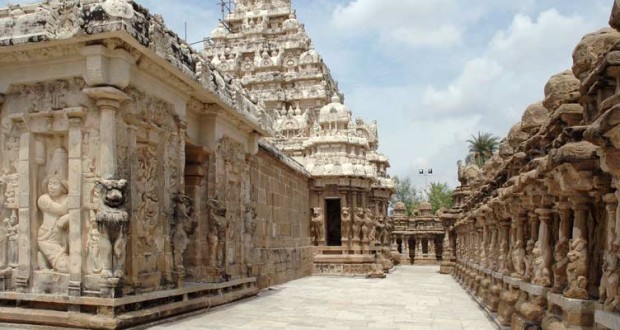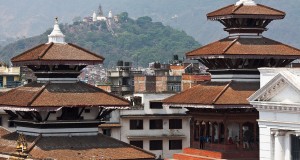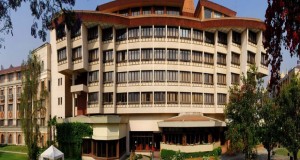Kailasanathar Temple-Ekambareshwara Temple-Kamakshiammon Temple-Vaikuntha Perumal-Varatha Temple
A short 15-minute cycle ride down Nellukkara and Putteri Streets takes you to the west of town, and the 8th-century Kailasanathar Temple. This lies in a garden clearing, and the giant Nandi bull in the grounds tells it’s a Shiva temple. The structure itself is very early Dravidian architecture—apart from the front, which was added later by Mahendra Varman III. 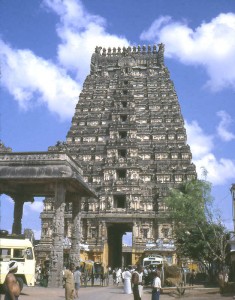 Delightfully simple and elegant, it has none of the decorative ostentations which were the hallmark of the later Chola and Vijayanagar building styles. Built of sandstone, it has some beautiful carvings and sculptures (some well-renovated), and remnants of bright fresco paintings still cling to a few of the 54 small shrines running round the inner courtyard, giving an idea of the temple’s original magnificence.
Delightfully simple and elegant, it has none of the decorative ostentations which were the hallmark of the later Chola and Vijayanagar building styles. Built of sandstone, it has some beautiful carvings and sculptures (some well-renovated), and remnants of bright fresco paintings still cling to a few of the 54 small shrines running round the inner courtyard, giving an idea of the temple’s original magnificence.
Just left of Nellukkara and Putteri Street junction, you’ll find Ekambareshwara Temple, marked by its towering 57-m high rajagopuran. Inside, there’s an extensive temple compound surrounded by a massive stone wall, added by Krishna Devaraja (a Vijayanagar king) in AD 1500. Ekambareshwara probably derives its name from ‘Eka Amra Nathar’—Shiva, as ‘Lord of the Mango Tree’. The ancient mango tree in one of its compounds, which according to local tradition is over 2500 years old, is where Parvati is said to have done penance to Shiva, after misguidedly closing his eyes and plunging the whole universe into chaos. Pilgrims troop around the tree all day long, and will (after you’ve paid your camera fee) urgently insist that you join them. Actually, you are not allowed to see much more—Ekambareshwara is a living temple (the god still lives here, in the mango tree) and many of the other shrines are off-limits to tourists. No matter, you can still climb the central gopu ran for marvellous IE views down over the temple complex. Permission is granted by the temple curator, who is found behind the Thousand Pillar Temple inside the compound. This particular temple has a thousand pillars, a colourful display of temple chariots, and images of the various animal carriers who accompany the gods of the Hindu pantheon. Allow yourself a good hour at Ekambareshwara.
The most popular temple, Kamakshiammon (5 mins left out of Ekambareshwara), is dedicated to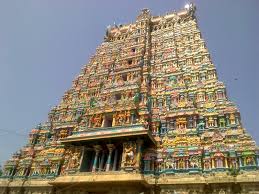 Parvati and is the site of the February/March Car Festival. As one of the three holy places of Shakti (Parvati as bride of Shiva), it is considered particularly auspicious for marriage-blessings, and up to 25 000 people show up at the larger festivals to supplicate the goddess for happy nuptials. Show up around 8 pm on Tuesday or Friday evening for fireworks and music, caparisoned elephants and vast, swaying crowds—the Golden Chariot cruises slowly round the temple grounds, and the moaning hordes part like the Red Sea in the Cecil B. de Mille movie. It’s a spectacle. By day, Kamakshiammon is surprisingly quiet and relaxed; a few visiting pilgrims stare appreciatively at the resident elephant, and you’re free to wander around unmolested. In its present form, the structure is a 14th-century temple of chola construction, its central ghat overlooked by watchtower gopurams.
Parvati and is the site of the February/March Car Festival. As one of the three holy places of Shakti (Parvati as bride of Shiva), it is considered particularly auspicious for marriage-blessings, and up to 25 000 people show up at the larger festivals to supplicate the goddess for happy nuptials. Show up around 8 pm on Tuesday or Friday evening for fireworks and music, caparisoned elephants and vast, swaying crowds—the Golden Chariot cruises slowly round the temple grounds, and the moaning hordes part like the Red Sea in the Cecil B. de Mille movie. It’s a spectacle. By day, Kamakshiammon is surprisingly quiet and relaxed; a few visiting pilgrims stare appreciatively at the resident elephant, and you’re free to wander around unmolested. In its present form, the structure is a 14th-century temple of chola construction, its central ghat overlooked by watchtower gopurams.
A short ride away, you’ll come across Vaikuntha Perumal. This is one of the oldest temples in town, dedicated to Vishnu and built by Parameswar Varman in the 7th century AD. It is most notable for its cloisters within the outer wall which are prototypes of the 1000-pillared halls seen at later temples like Ekambareshwara. There’s an interesting bas-relief circling the main shrine, which portrays battle scenes between the Pallavas and the Gangas/Chalukyas, also various depictions of Vishnu sitting, standing and lying down.
A rather alarming bus ride from the Nellukkara St stand, just up from Raja’s Lodge takes you 4 km (21/2 miles) across town to Varatha Temple. Recently renovated, this temple is in 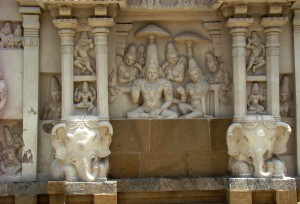 fine condition and features one of Kanchipuram’s finest gopurams, and the views from the top are stunning. There’s also an agreeable temple elephant contributed by the Elephant Shed Foundation, which will take you for a short ride round the grounds. Pay your camera fee, and head for the central 100-pillared Marriage Hall. The pillars are notable for fine base-carvings, of Vishnu (warrior-horses), Parvati, Ganesh, Brahma, Shiva and Buddha. The raised plinth within is the marriage platform, with seating space for wedding guests. In the corner lives the gloriously painted wooden chariot of Varatha (Vishnu). It is carried round town on festival days. Beyond the marriage hall is the large temple ghat, and two small shrines. The small stone marquees dotted round the marriage hall are for pilgrims to relax under, tucking into popular temple sweets like lemon-rice laddoo.
fine condition and features one of Kanchipuram’s finest gopurams, and the views from the top are stunning. There’s also an agreeable temple elephant contributed by the Elephant Shed Foundation, which will take you for a short ride round the grounds. Pay your camera fee, and head for the central 100-pillared Marriage Hall. The pillars are notable for fine base-carvings, of Vishnu (warrior-horses), Parvati, Ganesh, Brahma, Shiva and Buddha. The raised plinth within is the marriage platform, with seating space for wedding guests. In the corner lives the gloriously painted wooden chariot of Varatha (Vishnu). It is carried round town on festival days. Beyond the marriage hall is the large temple ghat, and two small shrines. The small stone marquees dotted round the marriage hall are for pilgrims to relax under, tucking into popular temple sweets like lemon-rice laddoo.

